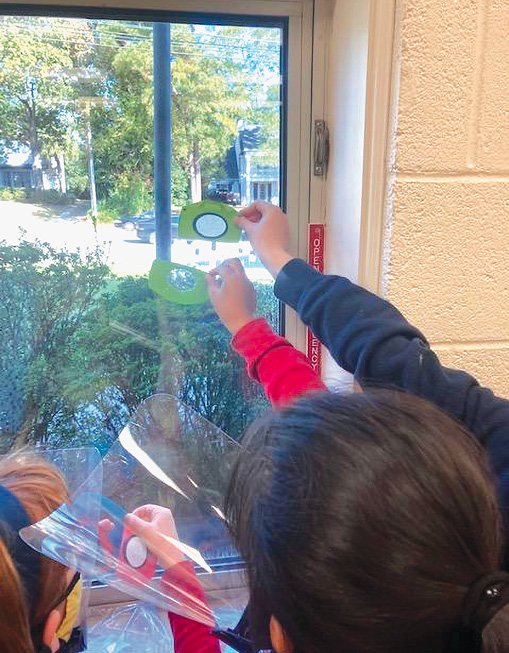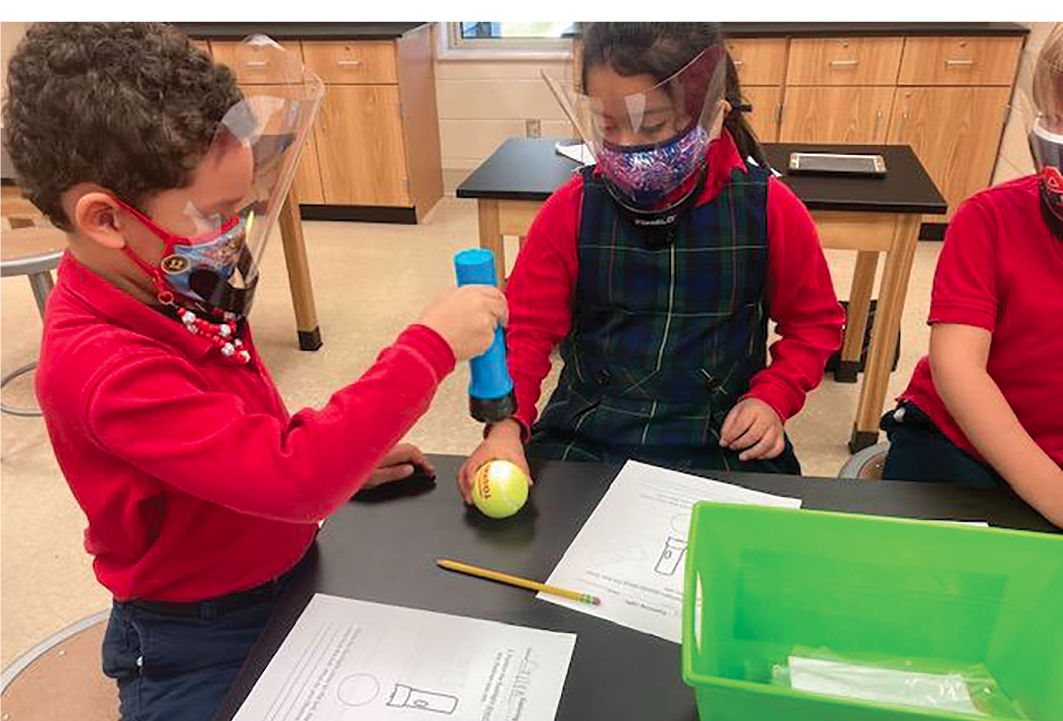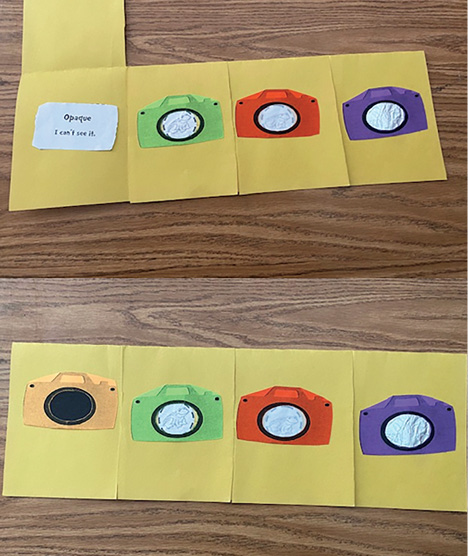feature
The Language of Science
The Exploration of Shadows
Science and Children—November/December 2021 (Volume 59, Issue 2)
By Bridget Miller, Christie Martin, and Diane Ford

Ms. Ford gathered her first-grade students on the carpet and held up the book Moonbear’s Shadow by Frank Asch (2000), “Who can tell me something they observe about the cover?” she prompted. Students began to share what they saw on the cover, “There is a bear!” “He is jumping!” Ms. Ford read the title, asking, “What might this book be about?” One student noticed the shadow on the cover “look, there’s his shadow, it’s about his shadow!” Through the use of read- alouds, Ms. Ford introduced students to the science concept of the day, shadows. Over the next two days, the class engaged in an integrated literacy 5E lesson (Bybee 2015) exploring the NGSS (2013) standard 1-PS4-3, (Plan and conduct investigations to determine the effect of placing objects made with different materials (opaque, transparent, translucent) in the path of a beam of light). The overall ob
Ms. Ford gathered her first-grade students on the carpet and held up the book Moonbear’s Shadow by Frank Asch (2000), “Who can tell me something they observe about the cover?” she prompted. Students began to share what they saw on the cover, “There is a bear!” “He is jumping!” Ms. Ford read the title, asking, “What might this book be about?” One student noticed the shadow on the cover “look, there’s his shadow, it’s about his shadow!” Through the use of read- alouds, Ms. Ford introduced students to the science concept of the day, shadows. Over the next two days, the class engaged in an integrated literacy 5E lesson (Bybee 2015) exploring the NGSS (2013) standard 1-PS4-3, (Plan and conduct investigations to determine the effect of placing objects made with different materials (opaque, transparent, translucent) in the path of a beam of light). The overall objectives for the two-day exploration included:
- Make observations about light and shadows (Day 1)
- Communicate concepts about light and shadows to prior experiences (Day 1)
- Identify if a material is opaque, translucent, or transparent (Day 2)
- Give examples of items that are opaque, translucent, or transparent (Day 2)
- Conduct an investigation to determine how light travels through materials that are opaque, translucent, or transparent. (Day 2)
- Determine how the position of the light source affects a shadow (Day 2)
This article explores how Ms. Ford integrated literary tools to engage students in higher-level thinking and meaning making (Tytler and Aranda 2015). Through the use of teacher talk, eliciting responses, asking for clarity, and expanding on student responses, Ms. Ford utilized discourse to support students in making meaning. Throughout the lesson, Ms. Ford infused reading and writing strategies to enhance students’ ability to read and write about science. It is important to note these strategies are not limited to Ms. Ford’s science instruction but are used across content areas. Figure 1 highlights the ways Ms. Ford uses strategies to develop language and sense-making throughout the day in mathematics, science, reading, word study, and social studies.

Literacy integration strategies.
Day 1 Engage
The use of both fiction and nonfiction text can support science concepts in the classroom. Ms. Ford chose a fiction book that contains the science concept (shadows) but does not explain the concept. This allows Ms. Ford to activate prior knowledge, help students make connections to prior experiences, and spark conversation and inquiry. As she read, she prompted students through guiding questions “What is happening in the book? What do you predict? What is Moonbear seeing? Why? “Have you ever seen something similar?” As students replied to her questions, they also supported their reasoning (Figure 2). For the first day of the lesson, Ms. Ford’s objective was to get students to identify prior experiences with shadows, make observations about light and shadow, and begin to develop ideas about why we see shadows. Ms. Ford used teacher talk to probe students’ discussion. For example, when a student mentioned “The Sun is changing,” Ms. Ford sought clarification and expansion, “What do you mean by changing?” This led to discussion about the Sun’s position in the sky in relation to Moonbear, and how it made his shadow appear different. Ms. Ford usedthe read-aloud strategy to have a collaborative conversation about the text, make predictions, and use teacher talk to elicit responses, and expand on student responses. This activity allowed students to start reflecting and sharing their understanding of how shadows are formed. It is evident students recognize the role of light in forming shadows.

Moonbear anchor chart.
Following the reading, Ms. Ford provided the students with a recording sheet and clipboard to go on a shadow walk. Students walked around the courtyard space and recorded their observations. To differentiate, students were able to draw their observations or write out descriptions of their observations. Students were directed to observe where they observe shadows and why they think they see the shadows where they do. The chart asked students to record what they noticed and what that made them think; this reflected the type of prompting Ms. Ford uses during read-alouds and discussions. Once back at the classroom, students’ observations and ideas were recorded on a class anchor chart. The shadow walk was used as an experience where students gather information, record their observations, and share their ideas. Students made connections to their own shadow walk and their discussion of Moonbear. Students indicated that it was a good day for shadows since it was sunny outside. One student indicated that they saw their own shadow because “the Sun reflects your shadow” while another indicated that our “shadow blocks the Sun” and another stated, “It’s us blocking the sunlight.” Ms. Ford reinforced students’ ideas about “us blocking the Sun.” The class discussion allowed Ms. Ford to identify misconceptions and student thinking. For example, one student mentioned “The Sun is orbiting.” This opened discussion about what was orbiting (Earth, not the Sun). These discussions helped guide the explorations the following day.
Day 2 Explore
The following day, Ms. Ford reinforced students’ ideas from the previous day about “blocking light” and the position of the Sun from the class anchor chart. For the second day of the lesson, Ms. Ford’s objectives were to help students plan and conduct investigations to determine the effect of placing objects made with different materials, in the path of a beam of light. To further explore these ideas, students engaged in exploration activities investigating light and shadows (1-PS4-3). Students had prior experience working in predetermined pairs with their table partners. These pairs were based on specific student needs; some were paired based on their reading groups, some were paired to support one another, for example a stronger reader and a weaker reader, and some were paired based on temperaments that paired well together. Due to the pandemic, students were to use hand sanitizer provided by the school before and after handling materials and wear their face masks at all times. All materials were sanitized before and after use. Before working in pairs, Ms. Ford modeled the proper use of materials (i.e., Not shining lights into eyes, keeping the ball on the table), went over the directions, and modeled how to complete the activities in the whole-group instruction.

Exploration 1
Students’ ideas in the previous day, such as “light can’t go through” and “light is blocked” lead to the second investigation. This supported the objective, Conduct an investigation to determine how light travels through materials that are opaque, translucent or transparent. The use of the terms opaque, transparent, and translucent, were intentionally not used, so that students could develop their own descriptions of their observations and words to communicate them. Ms. Ford used guiding questions to spark students’ thinking, such as, “is light always blocked? Does it act the same way with all objects?” Students made predictions, tested, and recorded how light moves through different materials. Students were provided with transparent, translucent, and opaque materials to test; a flashlight; and their recording sheet. Students used either the flashlight or window and discovered that light can fully move through materials (transparent), partially move through materials (translucent), or be blocked by materials (opaque). Ms. Ford engaged students in a data sheet that is modeled after a semantic feature analysis.
A semantic feature analysis includes terms in a column and features going across the top row, and students place a check or plus sign to show a connection between the term and the feature. It is built on the theoretical foundation of schema theory with the purpose of revealing connections between terms and concepts (Anders and Bos 1986). Ms. Ford uses this tool to organize student thinking and prior knowledge before testing the items. The features of “light travels through,” “some light travels through,” and “no light travels through” will become the intended vocabulary terms. Completing the form allowed students to make connections and use their predictions to understand science concepts.
Ms. Ford decided to walk students through their predictions to ensure their semantic analysis grid was filled out with their predictions prior to starting their investigation. Guiding questions included, Do you think light will travel through? Do you think some light will travel through? Do you think no light travels through? At this point in the exploration, the vocabulary terms (opaque, transparent and translucent) have yet to be named. Ms. Ford reiterated the questions for students to consider when making predictions, implores them to think about reflection, and begins to solicit predictions from students with their reasoning. Ms. Ford checked that each student has made their predictions on their grid and they move onto exploration. Students then had 10 minutes to work in their preassigned pairs to test materials and compare their predictions and their findings.
After working with a partner to collect data for 10 minutes, Ms. Ford brought the class back together for a whole-group discussion of their findings. Examples of students’ findings included, “For wax paper, some light comes through it. I tested with the window.” Students compared their findings with their predictions, several students shared they predicted only some light would go through. One student shared that they didn’t think the light would go through. The class walked through and discussed each material tested. Ms. Ford reinforced the question, “Does light travel the same way through all materials?” Students all replied with a resounding “No!”
Exploration 2
Next, students made predictions, tested, and recorded data related to how the position of light impacts shadows. This addressed the objective, Determine how the position of the light source affects a shadow. Students used a flashlight, a tennis ball, and their data collection sheets to move the flashlight’s position and record the shadow they observed (Figure 3). Students observed that the shadows are impacted by the angle of the light cast onto the object. While students worked in pairs to complete the activity and worksheet, Ms. Ford rotated around the room and engaged students in guiding questions and group discussion and provided support as needed.

Exploring light data sheet.
Ms. Ford: How are shadows created?
Students: Some light bumping into something it reflects. When no light can go through then there is a shadow.
Ms. Ford began the discussion by eliciting from students how shadows are created. The students’ responses indicated they have a misconception or are not explaining their thinking clearly.
Ms. Ford: Not reflecting the shadow, what is happening? (she models with the flashlight and tennis ball.)
Student 1: It’s blocking the light; shadows are made from blocking the light.
Student 2: None of the light can go through the ball.
Ms. Ford: Yes, a shadow is the lack of light.
Ms. Ford sought clarity by prompting them to rethink the idea of reflecting shadows and modeling the exploration again. Students changed their responses from reflecting a shadow, to blocking, or lack of light. They continued their exploration with different positions of the ball and flashlight.
Ms. Ford: What did you learn?
Student: No light makes a shadow.
Student: We got a shadow when it was on the side.
Ms. Ford: How is a shadow formed?
Student: By an object in front of light, and the light can’t come through.
Ms. Ford: What if the ball was clear? Made of glass?
Student: There wouldn’t be a shadow because the light would go through it like a window.
Ms. Ford continued to confirm with students what they were observing and learning from the exploration. Ms. Ford noticed the opportunity to extend working with shadows by allowing some time for shadow puppets.
Ms. Ford: What happens with shadow puppets? (Uses flashlight and hand to make a hand puppet)
Student: We block the light to make a puppet.
Students were excited as Ms. Ford closed the activity by prompting students to apply their knowledge of shadows to the creation of shadow puppets. Students spent several minutes making shadow puppets on the wall and their desks. Developing and testing shadow puppets was done in following weeks as an extension.

Explain
After the data discussion, Ms. Ford brought the class back together as a whole group and introduced the scientific vocabulary. Ms. Ford intentionally waited until after students experienced the concept and developed their own descriptions, prior to connecting scientific terms such as opaque, translucent, and transparent.
Ms. Ford: The black paper where nothing light goes through, there is a word for that, does anyone know what it is? (wait time, no reply) It’s opaque, have you heard this word?
Student: I have, my mom said it.
Ms. Ford: What is a term for something where we can see through it, like a window?
Students: clear
Student: See through
Ms. Ford: Has anyone heard the word transparent before? Transparent means to see all the way through, which one of our materials is transparent?
Student: Plastic wrap
Ms. Ford: What about the material that lets some light through? (wait time no reply) We call this translucent; it means some of the light goes through, which one of our materials is translucent?
Student: Wax paper
Ms. Ford provided students with the scientific vocabulary (transparent, translucent, opaque) when the students had a concrete experience to connect with these terms. This was evident when they connected the term to the material used in the exploration. Ms. Ford led students through a discussion of items that fit each category. Students indicated that windows, eyeglasses, and clear drinking glasses were transparent; lamp shades, curtains, and sunglasses can be translucent; and walls, dogs, and tennis balls are opaque. This addressed the objective, Give examples of items that are opaque, translucent or transparent. A synthesis of the literacy strategies used by Ms. Ford throughout the second day is shared online (see Supplemental Resources).
Evaluation
Ms. Ford primarily relied on formative assessments over the two-day lesson, and utilized follow-up activities to check understanding. The performance indicators Ms. Ford used in her assessment of conceptual understanding were tied to statewide standards (demonstrate conceptual understanding of light and shadows; analyze and interpret data from observations to compare how light behaves when it shines on different materials and conduct structured investigations to answer questions about how shadows change when the position of the light source changes). Ms. Ford recorded notes of whole-group discussions such as the read-aloud and noted student responses as she circulated throughout activities. She used the written reflections to check for understanding. The following day, the students’ morning journal prompt asked students to draw or explain how a shadow is formed which was assessed. Ms. Ford uses a 1-4 rubric with 1 indicating students are not understanding the lesson’s science concepts to 4 students explaining (written, drawn, or orally) their thinking that shows a clear understanding of the lesson’s science concepts. A vocabulary flip chart was used to check understanding of the terms opaque, translucent, and transparent (Figure 4). The students cut out the defined terms and glued them inside the flip chart. For example, the first camera shows the lens covered by black paper and the students glued the term opaque inside. The four cameras have black paper, clear plastic wrap, wax paper, and tinfoil respectively.
The following week, students made shadow puppets as a learning center, where they reenacted the story of Moonbear’s shadow. Students had access to transparent, opaque and translucent materials and miniature shadow stages using envelopes and flashlights.
Ms. Ford’s first-grade students engaged in a guided exploration to observe how light travels through objects. The lesson connected to the opening read-aloud, activating students’ prior knowledge and opening up the class discussion about shadows and light. Throughout the lesson, students communicated their ideas using their own words to describe what they observed, for example “blocked light.” Students were given scientific vocabulary later in the lesson to connect to their experiences (Opaque). This lesson developed students’ scientific literacy and developed scientific vocabulary through shared exploration and discourse while addressing the three dimensions of learning (See Supplemental Resources). ●

Vocabulary flip chart.
Supplemental Resources
Download the rubric at https://bit.ly/2Z5Z858.
Bridget Miller (btmiller@mailbox.sc.edu) and Christie Martin are associate professors at the University of South Carolina in Columbia, South Carolina. Diane Ford is a first-grade teacher at St. Joseph’s Catholic School in Columbia.
Literacy Physical Science Teaching Strategies Elementary


